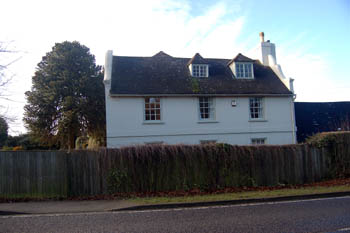Speedwell Farm Woburn

Speedwell Farm January 2008
Speedwell Farmhouse was listed by the former Ministry of Works in October 1952 as Grade II, of special interest. It is listed as “probably late 17th century in origin, reworked 1795-1802 for the Bedford Estate under direction of Robert Salmon”. The property is built in an H-plan and comprises two storeys and attics. There are various later lean-to additions.
The Rating and Valuation Act 1925 specified that every building and piece of land in the country was to be assessed to determine its rateable value. Speedwell Farm was assessed on 30th July 1926 in the morning and the valuer found [DV1/H5/4] that, like most of Woburn, the farm was still owned by the Duke of Bedford’s London and Devon Estates Company.
The farm was leased to Abbiss and Son whose rent was £338/10/- per annum, which had been fixed in 1921. The farm comprised 301 acres. The valuer noted: “Water laid on. Lighting Gas. Station Woburn Sands 3 miles. Drainage main into Woburn system. Station Woburn Sands 2½ miles” evidently he could not make up his kind how far the station was from the farmhouse! He continued: “Saw Mr. Edward Abbiss. He complains of the following points: - (1) Distance from station; (2) Superfluity of game; (3) Some land badly drained and the remainder too light”. Another hand wrote, on 17th September 1926: “A few of the grass fields are useful but the farm generally is of a wild, sandy nature”.
The farmhouse comprised a hall, three reception rooms, a kitchen, scullery, dairy and pantry downstairs, with a cellar under, and five bedrooms, a bathroom, a boxroom and a W. C. upstairs with two attics above that. The homestead was laid out as follows:
- Adjoining the house: a brick and tiled office, a nag stable for two with a loft over, two looseboxes and a harness room;
- West Block: a wood and tiled dairy, a cowhouse for twenty five, a barn temporarily divided into two as a store and chaff house, a granary and two coachhouses;
- North Block: a wood and slate loose box, a four bay open Cartshed and two looseboxes and a brick and slate five bay open cowshed with an open pen in front and a five bay open cowshed with an open pen in front and a loosebox;
- East Block: a brick and slate five bay open cowshed, a brick, wood and slated cowhouse for twelve temporarily divided into two and a loose box;
- Centre Block: four brick and tiled pigsties, a barn, a mixing house, a carthorse stable for six with a hay loft over, a store loft and a granary.
The valuer commented: “Tenant complains that these rooms and extensive buildings used for storage are entirely superfluous nowadays and were erected many years ago to accommodate horse traffic on the main road to London from the North”. In a nearby field was an open hovel and a loosebox.
Directories for Bedfordshire were not published every year but every few years from the mid 19th century to 1940. The following farmers at Speedwell Farm are identified:
- Henry Thomas Atterbury 1847, 1853, 1854 and 1862;
- W. E. R. Freeman 1869;
- Frederick Freeman 1877 and 1885;
- John Sear, 1890, 1894, 1898 and 1903 (he died in 1903 as a valuation of live and dead farming stock indicates [BML10/81/2]);
- Albert Skevington, 1906;
- Edwin Abbiss 1910 and 1914 (he and Wilfred took on the tenancy in 1910[SF84/3/9]);
- Henry Edward Abbiss, 1920, 1924, 1928, 1931 and 1936;
- William Burton, 1940.
We are able to take things back a little further. The parish dues register [P118/28/2] lists a name named Joseph Todd as the tenant in 1825 and Thomas Evans in his survey of 1822 also names Todd as the tenant [R1/240 and R2/68]. In 1806 the tenant was a man named Clayton who left in that year [R3/2124] and so may have begun his lease at the end of the 18th century; on his departure the stock was valued at £4,829, a truly huge sum for those days.